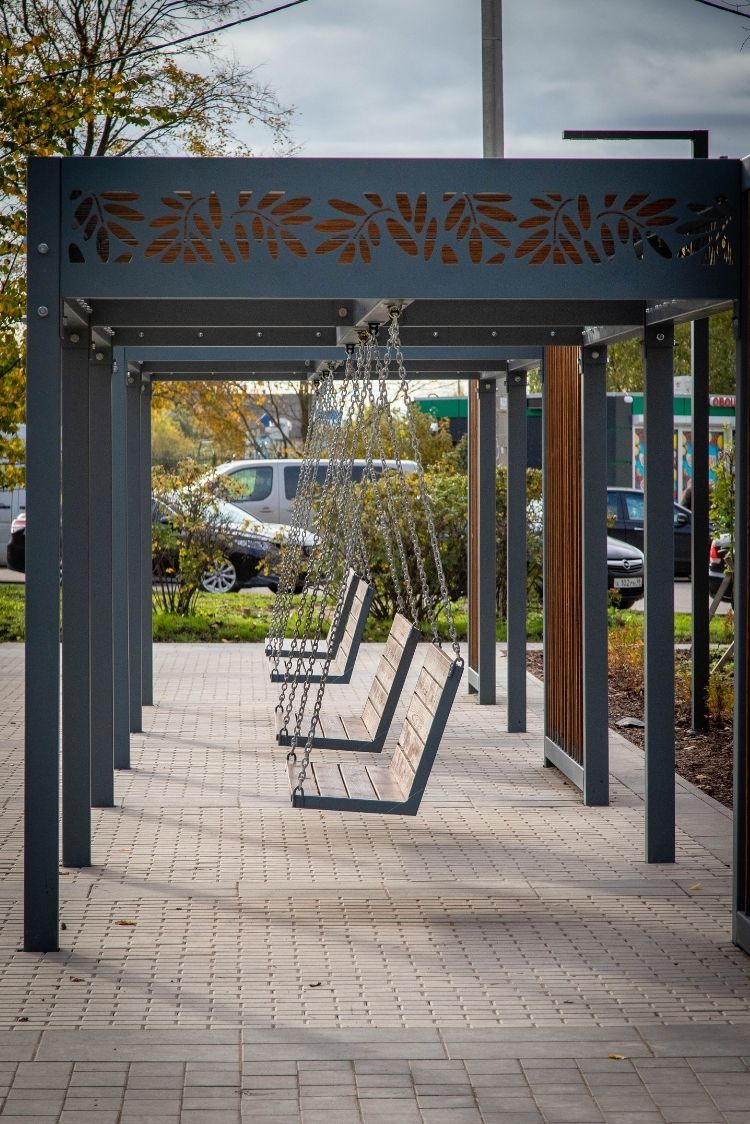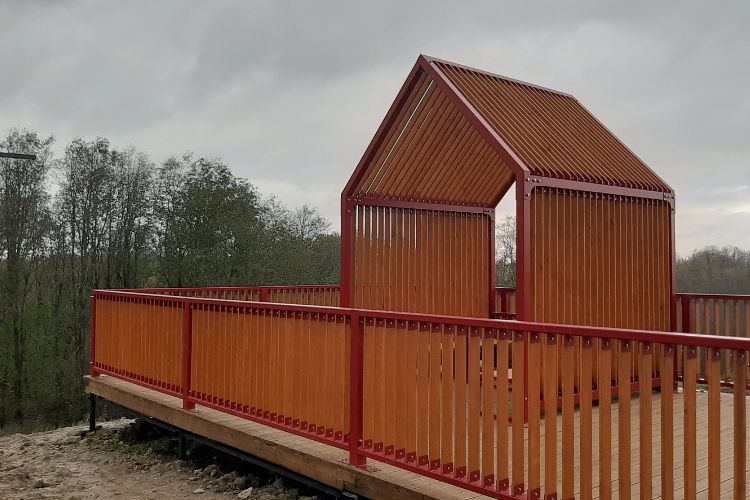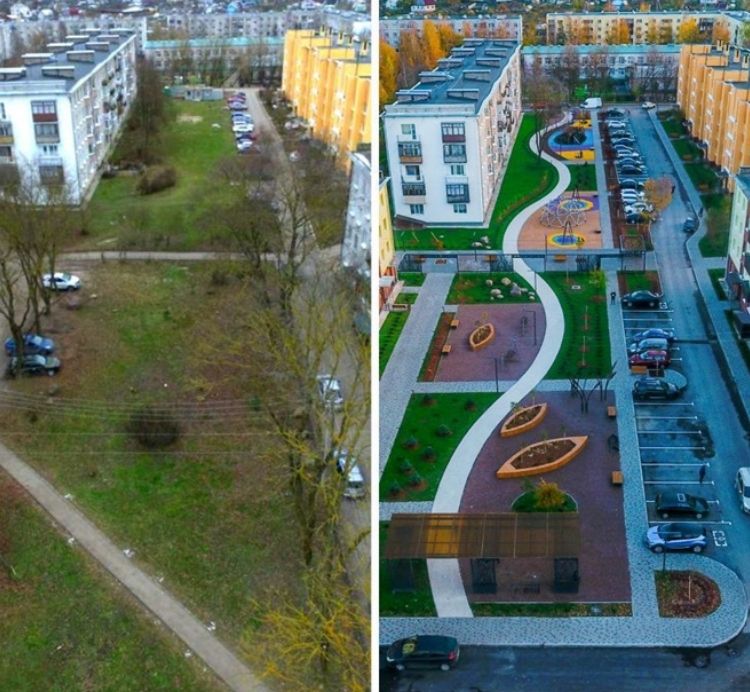Svetlana Danilova: «We Plan to Continue Working on the Improvement of Urban Environment»
The Ministry of Construction, Housing and Utilities of Russia has approved the federal register of the best urban improvement practices according to the results of 2019. The Leningrad Region became one of the leaders having soared from the seventeenth to second place due to a large number of projects presented. It is noteworthy that most of these projects were developed and implemented by specialists and graduates of the Department of Architectural Environment and Landscape Design of SPbGASU under the guidance of Associate Professor Svetlana Danilova.
Orzhitsy village: a new public space near the church
The town of Nikolskoye, design supervision (2020)
We asked Svetlana to tell about the factors that determined this significant progress and share her plans for the future.
– Our success in 2020 was a natural result of several years of intense work. It is based on an integrated approach and a special mission of the architect as a moderator of public life in cooperation with civil activists, contractors, media and specialized committees of government agencies. We can say that our Department has become a major driver for developing comfortable living environment in the region.
– How do you assess your experience in complex transformation of the urban environment in terms of improving the quality of life in towns and settlements of the region?
– Projects can be carried out in several stages. Our university specialists have showed how it works using the example of Villozsky settlement and Orzhitsky rural settlement in the Lomonosovsky district, as well as through other implemented projects that were awarded with numerous diplomas, certificates and prizes from the Leningrad Region’s government. We have introduced an approach that implies the settlement environment is considered as an integral whole at the concept stage, and includes developing an integrated master plan for improvement. Thanks to our proposals, the authorities can plan the project financing for several years in advance, and synchronize the replacement of engineering systems, renovation of facades and stairwells. A team of authors creates a single concept for improving the living environment as a whole, and it can be implemented in part, depending on organizational and financial capabilities.
There are many similar settlements – former state farms and military townships – across the country. Depressiveness is the common characteristic of those places. There are no visual landmarks, points of attraction and growth, and no conditions for comfortable leisure there. Morally obsolete, the landscape does not perform any functions – there’s no landscaping contributing to coziness and psychophysical comfort, relaxation, rehabilitation, creative development and education. But such settlements also have advantages – comfortable small scale, social control when everyone knows each other, closeness to nature. Our pilot projects on environmental design and comprehensive infrastructure renovation have become landmarks for the entire region. People see the results, and their trust in the government is growing.
An important result of the past year is the launch of the Leningrad Region’s Centre for Urban Competencies, where some of SPbGASU graduates are working. Together with my colleagues from the Regional Committee for Housing and Utilities, I acted as a consultant during its opening, and recommended candidates for management positions who were approved by the authorities. The organization’s team comprising my former students is performing quite well. In 2020, the Centre secured additional federal grants for regional towns, following their active participation in the “Small Towns and Historical Settlements” competition involving young architects, including our university staff. Besides, I take part in various educational events for municipal authorities, and it is one of the key areas of the Centre's work – this is a new level of exchanging experience accumulated in the region.
Nikolskoye: boulevard along Sovetsky Prospekt, thematic decoration
– Which of your decisions based on an integrated approach to organizing urban environment do you find most successful?
– For me, the greatest achievement is when, thanks to the implementation of our project, a previously dying settlement begins to revive, as it happened in the village of Orzhitsy, Lomonosov district. In cooperation with the local administration, we managed to achieve harmonious local aesthetics and authenticity, that is, originality and individuality of solutions, to reboot the environment, which entailed a cultural reboot: when a small park with an old alley is revived in an atmosphere of friendliness and trust, the residents start feeling joy and have sparkling eyes. At the same time, the expenses were relatively modest for a federal programme – an amount of only two million roubles was spent on improvements. It looks like a fairy tale. I see children playing in a human-friendly and safe environment, grandmothers sitting on the benches, couples walking with baby strollers – and I feel the urge to move on. I call human-friendly an environment where a person is at the centre of attention, and where conditions are created to help residents feel comfortable, develop, get inspired or relax.
– Please tell us about the current trends in the field of urban improvement and landscape architecture.
– Today, the main trend is the so-called participatory design, when sociologists, anthropologists, specialists in “smart city” systems, experts in the field of industrial design, business consulting, cognitive urban studies, and political strategists are involved in the environment design at initial project stages. Such an approach allows formulating the necessary functions and characteristics of the environment already at the stage of the technical assignment, to ensure its flexibility and all-season functionality, and take into account the opportunities for business, local communities, and increasing social needs of the population.
✔ In addition, already at the design stage, it is necessary to lay down mechanisms for overcoming administrative barriers.
Finally, an integral approach is a promising trend, its essence is in providing systematic solutions to environmental and medical problems: a human being is considered a part of nature, and a well-balanced landscape filled with a maximum of natural components opens up new opportunities for maintaining and restoring health. As Hippocrates once said: «The physician treats, but nature heals».
– Could you please tell about your further plans?
– Two years ago, Landscape Architecture was introduced and accredited by our university as a new field of study, which combines varied competencies in the areas of architecture, landscaping, soil science, botany and chemistry. The first Bachelor graduation will take place in 2021. We plan to continue working on the development of the urban environment, to strengthen communications with all stakeholders for creating decent living conditions in our regional towns and villages, and to further integrate the project activities with scientific research.
The most interesting things are happening today at the junction of different spheres. For example, there is a growing trend towards integrating therapeutic gardens into public spaces. Our colleagues from Sevastopol State University came up with an interesting idea to develop an educational programme for training landscape architects -therapists, which was presented at the international conference «Comfortable Environment is Healthy Environment».
PROJECT PARTICIPANTS TELL ABOUT THEIR WORK
Anita Popova
Graduates of the SPbGASU Department of Architectural Environment and Landscape Design, who took part in the regional improvement, have shared their impressions.
Anita Popova, a graduate of the SPbGASU Master's programme of 2019, specialist-architect of the Centre for Urban Competencies of the Leningrad Region:
– I gained my first professional experience working for the projects in Villozi and Malоye Karlino. These are large-scale projects with serious funding, and I have been observing their progress for several years. This experience helped me a lot to become a participant of the international educational programme "Architects.RF". When we worked on the improvement concept for the lower park in Orzhitsy, with a minimal budget, we managed to create a multifunctional and comfortable urban area. With the help of modern landscape techniques, the park has incorporated a variety of materials, types of landscaping and equipment. The accent on the key colour and specially designed architectural forms serve to emphasize the individuality and uniform style of the park. Recalling my participation in this project, I want to thank Svetlana Borisovna Danilova for this experience, the skills and knowledge I gained there allowed to kick-start my professional career.
Tatiana Volf, a Master’s graduate of 2020, specialist-architect in “FK-ramps” (the company is engaged in the design and construction of skate parks, snow parks and other extreme sports facilities):
Tatyana Volf
– I took part in a number of projects, among which the Garden of Memory occupies a special place. Last year I observed the project development in the village of Orzhitsy and the implementation of the second project stage of creating a public space at a shopping centre in Priozersk. In summer, together with Svetlana Danilova and Alena Dvornikova, we prepared the project design and estimate documentation for the Garden Square in Vyborg – it is the town’s historical centre and every architect would be interested to work there. My portfolio allowed me to find a job in a leading Russian company specialising in developing complex improvement facilities and the construction of skate parks. I successfully joined the young and energetic team of professionals thanks to the extensive experience I had gained while studying at SPbGASU. We keep in touch both as friends and as professionals, and we are ready to continue working together. Today, working remotely and setting up separate dynamic focus groups of architects and specialists in related fields for each project is a fashion trend.
Anna Belyaeva, a Master’s graduate of 2019:
– While I was still a student, I already achieved some important accomplishments together with Svetlana Danilova and Alexander Demin. My most memorable projects included Aleksandrovsky Park – this project was awarded at the competition held by St. Petersburg Government in 2017, and the landscaping concept for Smolyanoy Cape in Vyborg, which won the All-Russian competition for the best projects on developing comfortable urban environment in small towns and historical settlements in 2018. We were the first to break through. When you speak the same language with your teachers, it is easy to get everything done, it keeps you motivated. My final qualifying paper, dedicated to the strategic development of small towns, was awarded with a diploma of an international architecture festival. After working in Moscow, watching how Russia’s capital turned into a modern metropolis, I realized that SPbGASU is one of the strongest architectural schools. Architectural Environment and Landscape Design is a specialization which is in high demand now, all my fellow students are successfully employed, some of them found themselves in international architectural bureaus. Now we must develop the school further, and attract the best specialists. I would like to expand the exchange of experience with foreign universities and architectural companies.
Master's thesis defense at SPbGASU Department of Architectural Environment and Landscape Design in 2019
List of improvement projects developed by the SPbGASU Department of Architectural Environment and Landscape Design, which were implemented in the Leningrad region under the programme «Creation of a comfortable urban environment" in the framework of the national project "Housing and Urban Environment":
- Vsevolozhsky District: memorial to the victims of the plane crash in Sinai in 2015 – "The Garden of Memory";
- Lomonosov district, Maloye Karlino: comprehensive improvement of the village territory;
- Lomonosov district, Villozi: comprehensive improvement of the village territory;
- Lomonosov District, Orzhitsy: public space on Shkolnaya Street, Lower Park;
- Tosnensky district, Nikolskoye: public space – a path along Sovetsky prospekt;
- Tikhvinsky district, Tikhvin: "Park of Generations" – public space on Delegatskaya Street;
- Priozersky district, Priozersk: public space near “Severoparkovy” shopping mall;
- Volkhovsky district, Issad village: courtyard area;
- Vyborgsky district, Svetogorsk: town park;
- Vyborgsky District, Vyborg: Smolyanoy Cape.
The projects were carried out on the basis of research activities of the SPbGASU Department of Architectural Environment and Landscape Design, some of them have been recognized with professional awards and competition diplomas.
{gallery name="ДАН012021"}
Text: Tatyana Petrova
Photos provided by Svetlana Danilova
✔ Learn more about the Department of Architectural Environment and Landscape Design and its teachers







